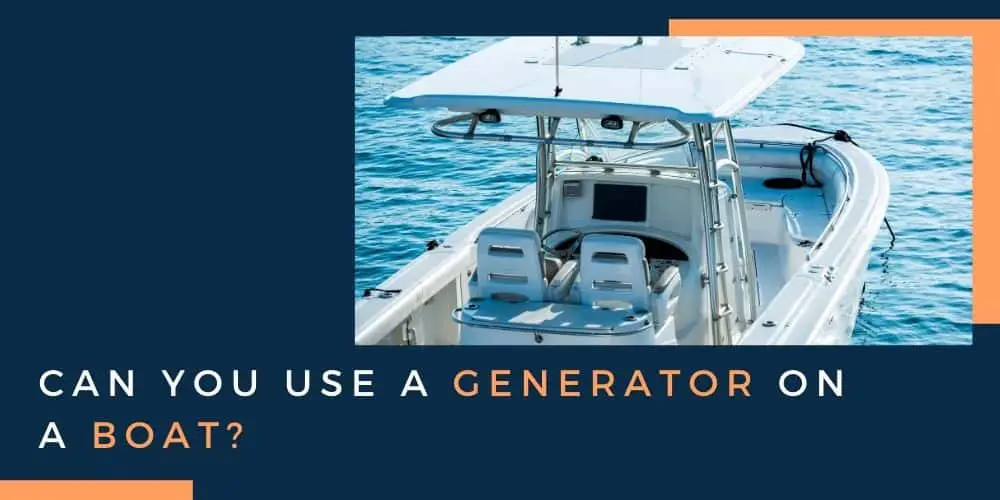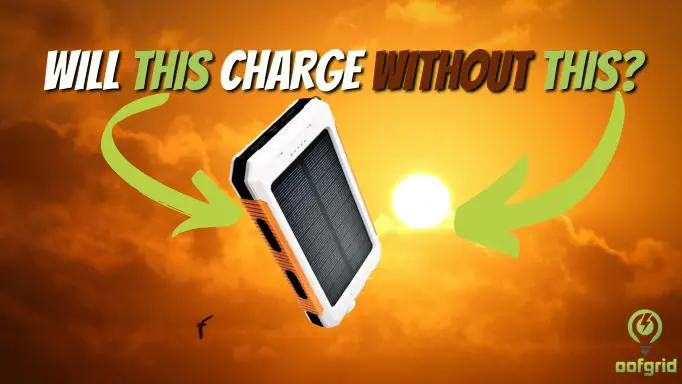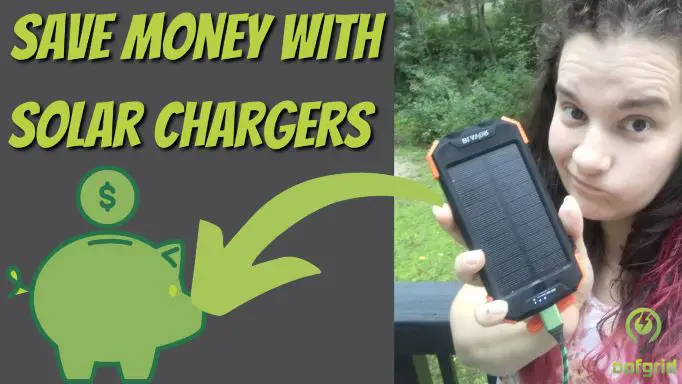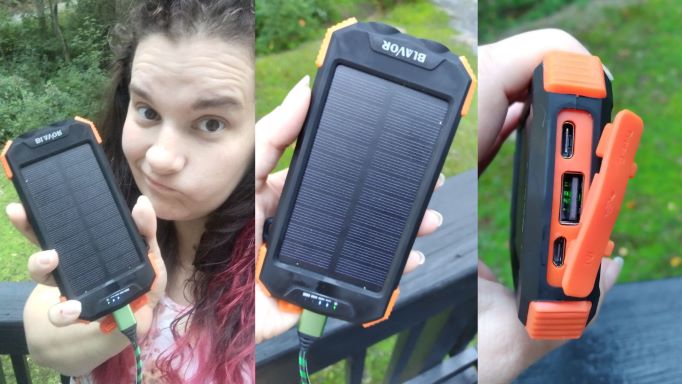The comforts and entertainment expected with modern boating often have energy demands that only an on-board generator can meet. A 12-Volt lead-acid battery isn’t always going to cut it.
But if mishandled or neglected while at sea, portable generators are a known fire hazard and have been associated with several boating accidents and fatalities.
But with care and diligence, a portable generator can safely be used onboard a variety of watercraft, especially if attention is paid to the type of generator and its positioning and operation.
In this article, we will equip you with the essentials of using a portable boating and marine generator on a boat with an emphasis on key safety considerations and practices as well as pointing you in the direction of some suitable models.
Well also take a look at alternative portable power solutions for boats of all sizes and pack in tips and hacks for power management when out on the water.
You might also like to read one of our other boating related posts:
Deep cycle batteries for boats
Portable generator review for boats
How to charge a battery on a boat

Contents
Having onboard power is essential to staying safe out on the water
If a weekend on the lake or by the marina is more than just pootling around in an aluminum Jon boat, you will know that you need a decent power supply for the safety and comfort of you and your guests.
Whether you partake of deep-sea fishing or entertain on a spacious pontoon boat you will rely on-board power to meet your electrical needs while cruising.
Most modern vessels are equipped with a range of instruments and devices and on-board energy consumption has increased steeply in modern times. Your boats electricity consumption can be for any of the following purposes and more:
- Radio communication: Boats rely on VHF radio to communicate with on-shore base stations and other watercraft. VHF radio operates across several channels including those that are reserved for emergency communication. VHF is also used for the Automatic Identification System, so your boat can be recognized and identify other vessels.
- Navigation: The days of fiddling with a sextant and hoping for the best are long gone. Most seaworthy vessels will be equipped with onboard GPS and sonar for pin-point navigation anywhere in the world. Satellite-navigation systems like GPS are big energy consumers for boats.
- Bilge pump: Smaller pumps located in awkward positions and are often battery operated. They are a critical safety device and can cause water build up in the hull of the boat if they fail. The pump may also be used for a livewell too.
- Refrigeration: Recreational boaters who undertake a cruise of more than 24 hours will find that a cool box is inadequate for storing food and drink. Serious anglers may also want a fridge on board.
- Air conditioning and heating: These will make cabins more comfortable and will add significantly to your boat’s power needs.
- Lighting: All vessels must carry white, red, and green navigation lights. Additional onboard lighting may be needed for cabins, as well as floodlights and underwater, LED lighting for anglers or powerboats.
- Tech: Music and computers may also be being used.

Typical onboard power consumption
Power requirements for a cruising sailboat will vary massively depending on the boat’s dimensions, the duration of its cruise, and the prevailing conditions at the time.
Liveaboard boaters may have consumption that is similar to living in a small apartment. Electricity consumption will be coming from the sources mentioned above, which are typical features on a boat’s energy balance sheet.
- For daily navigation of approximately 10 hours where a vessel will dock and recharge a 12 Volt battery power supply, typical electricity consumption will be in the region of 50 battery Ampere hours (50Ah) or 600 Watt-hours (Wh).
- For coastal navigation where the boat will be at anchor for a prolonged period (>24 hrs) demand will need to be met without the opportunity to recharge batteries. For safety, comfort and security onboard overnight, this type of navigation will require a means of generating electricity onboard. 24-hour energy consumption is approximately 93Ah or 1,000 Wh.
- If navigating offshore electrical autonomy is a must as the energy resources required are significant. Offshore navigation has average electricity consumption of 245Ah or 3000Wh.
Generating electricity onboard your boat
From the examples above it’s clear that batteries are not going to be sufficient for generating the electricity needed to keep you comfortable and safe at sea for a prolonged period.
Installing a permanent fuel power generator on your boat is a complex and expensive upgrade that can cost tens of thousands of dollars.
It is therefore understandable that a portable generator would appear to be a convenient solution for off-grid, onboard power. However, with good reason, it is not as simple as hauling your household portable generator and some fuel onboard and hoping for the best.
Why a portable generator might be a bad idea for a sailing boat
You are like to find equal numbers of mariners and boaters who advocate the use of portable generators on boats as those who are totally against the idea. Using portable generators while cruising is considered too risky for the following reasons.
- Bringing a portable generator aboard your boat will eat into your boat capacity.
Federal law specifies that boats that are under 20 feet in length need to carry a boat capacity plate which will state the maximum amount of weight your boat can safely handle.
Even portable gasoline generators can easily tip the scales, and when you add in gear, supplies, and people you may find yourself breaching your maximum gross load.
Overloading is extremely dangerous as your boat can become more difficult to control and easily swamped. The positioning of a weighty item like a generator is also a concern because the boat has to be evenly loaded and you may not be able to position it in a place where it can be operated safely.
- Having gasoline or other fuel onboard with your generator is a major fire hazard.
This is by far the most serious problem with having a portable generator on board. Boats at the best of times can be unpredictable environments and the combination of hot combustion engines, hot exhaust fumes, sparks, and fuel vapors can be a recipe for disaster!
Yachts have been lost through petrol vapors from a generator being ignited by a stove in the galley. If the generator is operated while the boat is underway, there is also a risk of it being tipped and leaking fuel.

- Water and electricity are a bad combination.
Rain and water splashing onto the generator are a significant electrocution risk. This complicates using a portable generator onboard as covering the generator or stowing it below deck also hazardous for the reason below.
- Poor ventilation below deck means that you could be exposed to deadly carbon monoxide.
Running a regular portable generator below deck is extremely dangerous as you do not have adequate ventilation for prompt dissipation of the exhaust fumes. This can lead to a dangerous build-up of colorless, odorless carbon monoxide that can kill very quickly.
- You may get evicted from your marina.
In most marinas the movement and handling of fuel is strictly controlled, meaning that the use of a portable gas generator is likely to be prohibited. There have been generator accidents that have sunk houseboats with fires that have been aggressive enough to spread to other houseboats.
How can I use a portable generator on a boat safely?
If you are determined to opt for a portable generator as your onboard power supply. You can keep yourself and other boaters safe by being extremely careful with the type of generator you select and how you use it.
[A] Ideally, look for a marine portable generator
Marine portable generators look pretty much identical to regular gas generators which often makes boaters think having a regular portable generator onboard is a good idea. However, there are differences in marine portable generators that will affect their performance and safety on your boat.
Boating generators are built to weather and waterproof specifications that means it will be up to the rigors of operating in a moisture-laden coastal environment.
In a marine environment, a regular generator is vulnerable to corrosion and is likely to break down easily. Marine generator components are made from reinforced metals with high-grade seals and durable pumps that can withstand the challenges of being on a boat.
They often come with a hard-wearing enclosure to reduce the exposure of components to salt air.
You can marinize a standard generator, by reinforcing seams in its casing and treating components with waterproof lubrication sprays or Rustoleum.
[B] Ventilation is a must when using your portable generator. Do not use the generator in an enclosed space. It is best used on a deck where you can be confident that it has adequate ventilation. Placing the ventilator in an aft position can help ensure fumes are carried away by the wind.
[C] Only use the generator when you are anchored or moored.
The generator should be placed on a level surface and should never be run while the boat is in motion. There is a high chance of fuel leakages and spills if you run the portable generator while you are underway, as well as the potential for splashes and spray that could get the generator wet.
You should not try to permanently install a portable generator on your boat, it may be temporarily secured in place.
[D] Avoid gasoline.
You may already be using propane or LPG in your galley for cooking, and this gaseous fuel may make a cleaner or safer option for generating electricity. A propane portable generator can be readily connected to an LPG gas tank which is easier and safer to handle and store. Diesel is also a slightly less volatile alternative liquid fuel.
[E] Do not refuel your generator on the boat.
If you are using gasoline or diesel, you should never fill the generator tank onboard your boat as this is a major ignition risk and has caused many accidents. Fill the generator on-shore and carry it onto the boat, checking it carefully for fuel leakage and spills.

[F] Keep the generator dry at all times. This can be a challenge while out on open water, especially as you have to have the generator on deck. A sun canopy or cowling may be used to protect the generator from rain, but shouldn’t preclude good ventilation.
[G] Remain vigilant when using a generator. If you have charge of a vessel, the operation of the generator will be your responsibility. Do not neglect to monitor the generator and ensure that it is safely positioned, stable, and operating properly.
Never leave the generator running while you sleep, even if moored, and do not rely on others to handle or check on it. It may also be prudent toinstall a carbon monoxide alarm for added protection.
[H] The generator will need safe secure storage when not in use.
When not in use, the generator should be removed from the boat and stored in a moisture-free locker that is not in proximity to any items that could damage it or cause fuel leakage.
Great portable generators for boats
When selecting a generator, be sure to sit down and calculate an energy balance sheet for your boat, so you will know the correct wattage of the generator you will need.
Handheld portable units provide the best ease of use and safe handling onboard a boat. Here are some of the best portable gas models that are used on boats on the market right now.
1. The EU2200i Portable Inverter Generator by Honda
KEY FEATURES
Peak wattage: 2200 Watts
Running wattage: 1800 Watts
Engine specs: Honda 4-stroke OHV air-cooled engine
Fuel: Gasoline
Starting: Recoil
Noise level: 48 to 57 dB
Outlets: Two 120 Volt 15 Amp AC outlets and a single 12 Volt 8.3 Amp DC outlet for battery charging
Dimensions: 16 inches by 20 inches by 11 inches
Weight: 40 pounds
Warranty: 3 year
This best-selling unit from Honda is often sold by chandleries as a portable marine generator. It is relatively lightweight and easily carried on and off your boat by hand.
Hondas classic four-stroke OHV engine is put to good work in this compact generator design that delivers approximately 1800 running watts and can even be doubled up by running a second EU2200i in parallel.
Depending on its load, this portable generator can run for up to 10 hours on a single tank (0.95 gallons) of fuel. The inverter design ensures clean power that can be confidently used for electronics.
You will also notice how quiet the operation of this generator is, meaning conversation and entertaining onboard is not interrupted.
Pros of the EU2200i Portable Inverter Generator by Honda
- Proprietary Oil Alert® function will alert you when engine oil runs low.
- It also has an LED overload alarm and output indicator.
- A handy cover is available for purchase when the generator is not being used.
Cons of the EU2200i Portable Inverter Generator by Honda
- 1800 running watts may not be adequate for the power requirements of a boat for prolonged periods. Plan your power usage and upgrade if necessary.
2. iGen2200 Portable Inverter Generator by Westinghouse
KEY FEATURES
Peak wattage: 2200 Watts
Running wattage: 1800 Watts
Engine specs: 79cc 4-stroke OHV engine
Fuel: Gasoline
Starting: Recoil
Noise level: 52 dB
Outlets: Two 120 Volt 20 Amp outlets and 2 USB ports
Dimensions: 19.8 inches x 11.4 inches x 17.9 inches
Weight: 46 pounds
Warranty: 2 year
This all-over camo portable generator by Westinghouse is ideal for getting out on the water for duck season. It is covered in a smart TrueTimber design that will keep it imperceptible to waterfowl and also has a whisper-quiet function. It makes a great choice for marine settings as it is handheld, weighing about the same as a 4 or 5-year-old child.
With a 1.2-gallon gas tank, you will be able to get up to 12 hours of power out of your generator. It can also be run in parallel with another identical generator to double-up on available power. It is a pull start generator with the recoil recessed on the side of the unit.
The power outlets include USB ports that are ideal for convenient powering of phones, GPS, and other tech with clean stable power that has a total harmonic distortion (THD) of less than 3 percent.
Pros of the iGen2200 Portable Inverter Generator by Westinghouse
- The highly portable and ergonomic design makes this gas generator easy to safely handle on your boat.
- Use the Economy Fuel Efficiency mode to get the maximum value from every drop of gas!
Cons of the iGen2200 Portable Inverter Generator by Westinghouse
- Some owners of this generator report teething problems with the recoil start making it difficult to get the generator going.
3. Gp2200 Portable Inverter Generator by Generac
KEY FEATURES
Peak wattage: 2200 Watts
Running wattage: 1700 Watts
Engine specs: 4-stroke OHV engine
Fuel: Gasoline
Outlets: 12 Volt DC outlet 120 Volt 14.1 Amp AC outlet and USB outlet
Dimensions: 19 inches x 11 inches x 17 inches
Warranty: 2 year
Outdoor enthusiasts on land and sea will find this compact handheld generator a reliable companion for off-shore trips. It uses proprietary TruePower technology to convert your fuel into clean power that is suitable for even the most sensitive electronics.
It has a running wattage of 1700 Watts which is adequate for powering basic equipment for over 10 hours with a 25 percent load.
The unit has a simple design and clean lines with a simple front panel for the outlets. Indicator lights also alert to low-oil levels and overloading, while a start dial integrates the choke, run and stop settings.
Pros of the Gp2200 Portable Inverter Generator by Generac
- This generator can also be run in parallel by purchasing a second identical model with the connection kit.
- The Generac portable generator also has an economy setting that gets additional value from your fuel.
- Quiet operation is a feature of this generator that is noted by owners.
Cons of the Gp2200 Portable Inverter Generator by Generac
- Pouring oil into the generator can get a little messy.
Alternative options for onboard power for boats
If your boat is too small to carry a fuel generator on-board safely or your power requirements are greater than can be served by a small portable generator you may want to explore alternative power sources for your boat.
Alternative and sustainable power for boats is growing in demand. Here are some accessible and affordable options you can use on your boat immediately:
(a) Power stations
The days of relying on a rusty old 12 Volt battery are long gone with smart and sustainable battery power stations that are ideal for servicing tech gear and navigational equipment on board.
These handheld units are useful for separating your on-board energy use and they can be readily charged overnight when you dock at a marina.
EXAMPLE:
The Jackery Portable Power Station
- Included in the Best Portable Power Station for use in the outdoors by Digital Trends.
Prices pulled from the Amazon Product Advertising API on:
Product prices and availability are accurate as of the date/time indicated and are subject to change. Any price and availability information displayed on [relevant Amazon Site(s), as applicable] at the time of purchase will apply to the purchase of this product.
KEY FEATURES
Specs: 240 Wh / 67000 mAh Lithium ion battery
Wattage: 200 Watts
Outlets: AC outlet (110 Volt), DC car port USB outlets (5 Volts)
Weight: 6.6 pounds
Dimension: 5.19 inches x 9.05 inches x 7.67 inches
Warranty: 2 years
This handy unit can deliver clean sine wave AC power to a range of devices. It can fast-charge a mobile phone fully up to 24 times! For the amount of power you get, the Jackehydro-generator power station is incredibly lightweight at only 6.6 pounds.
The smart LED display keeps you abreast of your power consumption and recharging via car outlet or mains takes under 6 hours. This power station can also be topped up with solar panels as we mention below.
Pros of the Jackery Portable Power Station
- This lightweight and compact unit will keep your passengers powered up without pushing your boat’s capacity.
Cons of the Jackery Portable Power Station
- This power station cannot be used to power items that have a wattage above 200 Watts, like blow dryers and appliances.
(b) Hydro-generators
Hydro generators take advantage of your boat’s movement through the water to generate electricity.
They are fitted to the hull of your boat and as water flows through the hydro generator an alternator converts the energy into electricity – a sustainable way of recharging onboard batteries!
These novel generators can cause some drag while sailing and will only operate when you are navigating.
(c) Solar generators
Solar panels use an array of photovoltaic cells that trap the sunlight and convert it into electricity for your boat. Installation of solar panels is a common energy upgrade for vessels that need energy autonomy.
If the installation is too expensive you can always purchase a solar panel charger that can be used to recharge batteries or power equipment directly.
EXAMPLE
120 Watt foldable solar panel charger by Togo Power
- This solar panel is designed for the most portable generator power station on the market, compatible with Baldr, Jackery, Goal Zero, Paxcess. If you have your own adapter, it can also be used with NexPow, ROCKPALS, SUAOKI, FlashFish. Also for mobile phones, power banks, tablets, laptops, GPS, digital cameras, etc. Ideally suited for outdoor life and even unexpected power outages.
Prices pulled from the Amazon Product Advertising API on:
Product prices and availability are accurate as of the date/time indicated and are subject to change. Any price and availability information displayed on [relevant Amazon Site(s), as applicable] at the time of purchase will apply to the purchase of this product.
KEY FEATURES
Wattage: 120 Watts
Outlets: Dual USB ports (15 Volts 3 Amps)
Weight: 10.25 pounds
Dimension: 20.47 inches x 14.57 inches x 2.17 inches
Warranty: 1 year
This smart folding solar panel is a portable solution for generating power on a boat for electronic devices including laptops, GPS, and phones. It is made up of 20-watt monocrystalline solar panels that have a high rate of energy conversion.
Unfolded you have a solar panel area of 1.66 meters by 0.52 meters. The panel can also be positioned using an adjustable kick-stand to obtain maximum exposure to the sun’s rays.
Pros of the 120 Watt foldable solar panel charger by Togo Power
- This neat solar panel can also be used to charge battery power stations like the Jackery power station reviewed above.
Cons of the 120 Watt foldable solar panel charger by Togo Power
- This power solution is reliant on receiving adequate sunshine, which is not guaranteed.
- This is a really popular model that has few downsides as a purchase for a boat of any class or size. You may want to double up on these to be able to power more equipment.
(d) Wind turbines
Larger vessels can harness the wind as a renewable energy source, A compact wind turbine can be installed at height on a mast or gantry and rotate to use the apparent wind for electricity generation.
This is an expensive option that will require additional equipment to be installed onboard, though it will generate energy if you are moored.
Rounding up
As you can see, generating electricity for our boat is not always a straightforward matter. If you decide to use a portable gas generator onboard, you must be fully aware of the risks and implement the measures necessary to keep yourself and your crew safe.
It’s great that there are so many sustainable and portable alternatives for powering electrical equipment on a boat. Feel free to experiment and combine solutions in a way that will work for you.
























